Structure and Distribution of the Gold-Related Quartz Vein Systems in the Southwestern Part of the Barberton Greenstone Belt (South Africa, Eswatini)
Abstract
:1. Introduction
2. Geological Setting
2.1. The Barberton Greenstone Belt and Surrounding Granitoids
- At ca. 3.55 Ga, the mafic to ultramafic lavas of the lower Onverwacht Group were formed, likely on top of the Ancient Gneiss Complex [58,59,60]. A period of intra-oceanic activity may be genetically related to these lavas [60]. The subsequent melting of a continental shield gave rise to the Steynsdorp pluton [27,39]. Around 3458 Ma, an early D0 event occurred, which involved hydrothermal alteration [30].
- At 3229–3227 Ma, a second deformation phase, D2, affected the entire belt during NW–SE shortening. D2 occurred during the intrusion of several TTG plutons (Kaap Valley, Badplaas, Nelshoogte; [30]). This tectono-magmatic event may have been caused by the subduction of the SE block under an NW block [30,44,52,61,62] or by vertical mass redistribution driven by the density inversion between the rising lighter TTGs magmas and the overlying denser upper crustal material [63]. The D2 deformation is interpreted to be coeval with the formation of the Fig Tree Group in a foreland setting [64].
- At 3226–3080 Ma, a renewed or continued NW–SE shortening accommodated by strike-slip shear zones created the D3 deformation and folded the earlier structures [30]. It marks the beginning of the collision and the suture formation between the two main NW and SE blocks [37]. In the belt, the Inyoka fault system corresponds to a large-scale thrust bringing the NW block in contact with the SE block [60]. Within the granite-gneiss block, this fault extends to a ductile deformation zone bringing in contact the Badplaas (NW) and the Stolzburg blocks (SE) [39,52]. In such a scenario, the Moodies Group sediments are interpreted as deposited in a syntectonic basin formed during the orogenic collapse that follows this event at 3.2 Ga [33].
2.2. Gold Mineralisation throughout the Barberton Greenstone Belt
2.3. The Malolotja Synform and the Steynsdorp Anticline Areas and Their Gold Occurrences
3. Lithostratigraphy
4. Regional Deformation
4.1. Early Event (De)
4.2. Main Fold-Related Event (Df)
4.3. Late Event (Dl)
5. Hydrothermal Vein System
5.1. Vein Macroscopic Study
5.1.1. Early Veins System
5.1.2. Mineralised Veins System
5.1.3. Late Vein System
5.2. Vein Microscopic Study
5.2.1. Petrography
5.2.2. Microstructures
5.3. Alteration
- Although most of the early veins do not show alteration features, few of them exhibit greenish-to-whitish mm to dm scale alteration halos, mainly in the Malolotja area (Figure 8a).
- At Malolotja, green alteration halos around quartz veins of the Primrose occurrence traduces the existence of alteration (Figure 15a). At Steynsdorp, mm large cubes of pyrites and ankerite crystals are found in the host rock adjacent to mineralised quartz veins (Figure 15b). Brown/red leaching of the country rock is also observed in the vicinity of mining areas (e.g., She mine, Waverley Reefs, Welcome, Figure 4c).
- NE–SW-striking tourmaline or oxide veins have been observed locally in the eastern limb of the Malolotja synform in both the Onverwacht and Moodies Groups (Figure 15c,d). These veins are supposed to be part of the late barren system. Both veins exhibit alteration effects with, respectively, leaching (Figure 15c) and/or tourmaline impregnation (Figure 15d). One of the best alteration features observed within the entire studied area is the large alteration halo present at the edge of the late vein of the outcrop Lo.43, in which mm large radial or elongated tourmaline is visible (Figure 11b–d).
6. Interpretation
6.1. Main Results
- Three main tectonic events have been identified in the vein systems and adjacent country rocks. Three schistosities and associated folds are recognised: (i) Se cleavage (De early event), which is interpreted to be initially E–W striking and dipping to the north at Steynsdorp and to the south at Malolotja; (ii) Sf cleavage (main fold-related event) related to the large-scale N–S-trending folds; (iii) and Sl cleavage (late Dl event) N130°E striking. Stretching lineation occasionally occurs but is not well expressed in the study area.
- Similarly, three generations of veins have been established:
- -
- Early veins are cm to dm thick, mostly sigmoid in shape, and wrapped by Se and/or folded by Df events. Veins are mostly filled by quartz and carbonates with or without green alteration halos composed of talc, tourmaline, and albite.
- -
- Mineralised veins have various orientations: shallow-dipping, steeply east- and steeply west-dipping. They are the most abundant, thicker (cm to m thick), interconnected, and thus coeval (Figure 16). The steep veins have orientations varying from N–S-striking (most frequent) to N140–150-striking. The mineralogy of these veins is mainly quartz, carbonates, feldspar, tourmaline, and sulphides with alteration halos of pyrite, tourmaline, feldspar, and talc.
- -
- A late vein system was observed exclusively in the Malolotja area. Their geometry is variable, i.e., flat sheared veins, oblique dipping tension gashes, weakly folded N050-striking steeply dipping to the NW metric veins. These veins are composed of quartz, feldspar, and muscovite with an albite, tourmaline, and muscovite alteration halo, similar to the ones of the mineralised system, even if best-expressed.
6.2. Tectono-Hydrothermal Evolution of the Southern Barberton Greenstone Belt
- The initial stage shows a subvertical to south-dipping Se schistosity in the Malolotja area, likely related to the Onverwacht Group overthrust on the Moodies Group rocks, as suggested by Heubeck et al. [79] and Lamb and Paris [84] (Figure 17a). At Steynsdorp, the Se schistosity is subvertical to north dipping. According to Lana et al. [65], Se formed as a response to unroofing of the Steynsdorp metamorphic core complex. Early quartz veins formed during this stage and were subsequently folded by the following events. Early quartz veins are related to this event (Figure 17a).
- The second event, Df, results in this southern part of BGB from E–W shortening and corresponds to the formation of large-scale folds, i.e., the Steynsdorp anticline and Malolotja synform. The E–W shortening direction is obtained as normal to the Sf schistosity plane, presuming that the deformation Df is coaxial. This inference is based on consistent cleavage orientations, fold geometry (e.g., similar fold axial plane orientations and axis, Figure 6b), and lack of stretching lineation associated with Df. An associated N–S-striking axial planar schistosity Sf is created in several places (in red in Figure 17b). During this stage, most of the gold-bearing and/or gold-related hydrothermal quartz veins are emplaced, i.e., the horizontal and steep veins (Figure 16 and Figure 17b). The association between horizontal and steep veins demonstrates their syntectonic character (see the discussion below), also confirmed by (i) upright Ff folding of the horizontal veins formed and opened in mode I character and (ii) internal texture of horizontal veins, showing vertically elongated tourmaline and quartz grains, indicative of vertical (sometimes slightly oblique) opening. In addition to the vertical tourmalines, feldspars and fibres and comb quartz are perpendicular to the vein edges (Figure 9b,d and Figure 14c)—the local development of elongated and/or truncated tourmaline and feldspar in alteration halo also confirms the syntectonic character (Figure 13). Generally, N–S-striking, steeply west-dipping veins formed during reverse faulting (e.g., Figure 9f and Figure 16). The associated shallower veins (either dipping towards the west or the east) opened as shear planes in an R or R’ position. The complexity of this model lies in the fact that all these veins are synchronous (e.g., Rosehill and Primrose, Figure 9a,e and Figure 16). Moreover, some of the flat-to-shallow-dipping veins are folded by Sf (e.g., Ivanhoe, Figure 9b and Figure 16) or contain vertically truncated tourmalines (e.g., Figure 14c), which confirms the syntectonic character of these veins and that they formed syn in the late Df.
- The third hydrothermal and deformation event is mainly recorded in the Malolotja area as the result of a NE–SW shortening, as determined by taking the axis parallel to the Sl poles. This deformation produced local folds and a NW–SE-striking Sl cleavage (in green in Figure 17c). In addition, this deformation controlled the emplacement of a late vein system, typified by N050-striking veins (Figure 11b, Figure 16 and Figure 17c) or shear veins displacing existing veins (Figure 11e). Currently, there is no indication justifying that this late vein system was associated with gold precipitation and/or concentration. Only the N050–070-striking veins of the late vein system have been represented in Figure 16.

7. Discussion
7.1. Vein Formation Model
- The orientations of the mineralised veins, which are generally striking N–S to N150 in our case, whereas they are mainly oriented NE–SW to ENE–WSW in the Sheba/Fairview systems. The structural control of the gold mineralisation is therefore interpreted with different shortening directions, i.e., E–W shortening in our case study while in the Fairview-Sheba area, they are controlled by NW–SE shortening [68,70]. The explanation of such a difference is proposed in the next chapter of the discussion. However, we note that the mineralisation-related veins are oriented perpendicular to the shortening axis direction in both models.
- It is worth noting that the Sheba/Fairview domains have been intensively exploited and are still active, whereas Malolotja/Steynsdorp areas were historically exploited with a minor gold production.
7.2. Significance of the Deformation Events
- Mineralogically, the two events show similar infilling and alteration halos (Figure 13).
7.3. Timing of the Mineralisation Event
8. Conclusions
Author Contributions
Funding
Data Availability Statement
Acknowledgments
Conflicts of Interest
References
- Belousova, E.A.; Kostitsyn, Y.A.; Griffin, W.L.; Begg, G.C.; O’Reilly, S.Y.; Pearson, N.J. The Growth of the Continental Crust: Constraints from Zircon Hf-Isotope Data. Lithos 2010, 119, 457–466. [Google Scholar] [CrossRef]
- Herzberg, C.; Condie, K.; Korenaga, J. Thermal History of the Earth and Its Petrological Expression. Earth Planet. Sci. Lett. 2010, 292, 79–88. [Google Scholar] [CrossRef]
- Nisbet, E.G.; Cheadle, M.J.; Arndt, N.T.; Bickle, M.J. Constraining the Potential Temperature of the Archaean Mantle: A Review of the Evidence from Komatiites. Lithos 1993, 30, 291–307. [Google Scholar] [CrossRef]
- Martin, H. Chapter 6 The Archean Grey Gneisses and the Genesis of Continental Crust. In Developments in Precambrian Geology; Elsevier: Amsterdam, The Netherlands, 1994; Volume 11, pp. 205–259. ISBN 978-0-444-81621-4. [Google Scholar]
- Condie, K.C. Archean Greenstone Belts; Elsevier: Amsterdam, The Netherlands, 1981; ISBN 978-0-08-086902-5. [Google Scholar]
- Gorman, B.E.; Pearce, T.H.; Birkett, T.C. On the Structure of Archean Greenstone Belts. Precambrian Res. 1978, 6, 23–41. [Google Scholar] [CrossRef]
- Van Hunen, J.; Moyen, J.-F. Archean Subduction: Fact or Fiction? Annu. Rev. Earth Planet. Sci. 2012, 40, 195–219. [Google Scholar] [CrossRef] [Green Version]
- Gapais, D. Tectonics-Mineralisation Relationships within Weak Continental Lithospheres: A New Structural Framework for Precambrian Cratons. BSGF-Earth Sci. Bull. 2018, 189, 14. [Google Scholar] [CrossRef]
- Barley, M.E.; Groves, D.I. Supercontinent Cycles and the Distribution of Metal Deposits through Time. Geology 1992, 20, 291. [Google Scholar] [CrossRef]
- Goldfarb, R.J.; Groves, D.I.; Gardoll, S. Orogenic Gold and Geologic Time: A Global Synthesis. Ore Geol. Rev. 2001, 18, 1–75. [Google Scholar] [CrossRef]
- Groves, D.I.; Vielreicher, R.M.; Goldfarb, R.J.; Condie, K.C. Controls on the Heterogeneous Distribution of Mineral Deposits through Time. Geol. Soc. Lond. Spec. Publ. 2005, 248, 71–101. [Google Scholar] [CrossRef]
- Boullier, A.-M.; Robert, F. Palaeoseismic Events Recorded in Archaean Gold-Quartz Vein Networks, Val d’Or, Abitibi, Quebec, Canada. J. Struct. Geol. 1992, 14, 161–179. [Google Scholar] [CrossRef]
- Anhaeusser, C.R. The Geology and Tectonic Evolution of the Northwest Part of the Barberton Greenstone Belt, South Africa: A Review. S. Afr. J. Geol. 2019, 122, 421–454. [Google Scholar] [CrossRef]
- Ward, J.H.W. (Map Compiler) Metallogenic Map of the Barberton Greenstone Belt, South Africa and Swaziland; 1:100000; Council for Geoscience: Pretoria, South Africa, 2000. [Google Scholar]
- Pearton, T.; Viljoen, M. Gold on the Kaapvaal Craton, Outside the Witwatersrand Basin, South Africa. S. Afr. J. Geol. 2017, 120, 101–132. [Google Scholar] [CrossRef]
- Anhaeusser, C.R. Archean Metallogeny in Southern Africa. Econ. Geol. 1976, 71, 16–43. [Google Scholar] [CrossRef]
- Agangi, A.; Hofmann, A.; Przybyłowicz, W. Trace Element Zoning of Sulfides and Quartz at Sheba and Fairview Gold Mines: Clues to Mesoarchean Mineralisation in the Barberton Greenstone Belt, South Africa. Ore Geol. Rev. 2014, 56, 94–114. [Google Scholar] [CrossRef]
- Altigani, M.A.H. Insights on Mineralogy and Chemistry of Fairview Gold Mine, Barberton Greenstone Belt, South Africa. Indones. J. Geosci. 2021, 8, 73–99. [Google Scholar] [CrossRef]
- Dirks, P.H.G.M.; Charlesworth, E.G.; Munyai, M.R. Cratonic Extension and Archaen Gold Mineralisation in the Sheba-Fairview Mine, Barberton Greenstone Belt, South Africa. S. Afr. J. Geol. 2009, 112, 291–316. [Google Scholar] [CrossRef] [Green Version]
- Dziggel, A.; Otto, A.; Kisters, A.F.M.; Meyer, F.M. Chapter 5.8 Tectono-Metamorphic Controls on Archean Gold Mineralization in the Barberton Greenstone Belt, South Africa: An Example from the New Consort Gold Mine. In Developments in Precambrian Geology; Elsevier: Amsterdam, The Netherlands, 2007; Volume 15, pp. 699–727. ISBN 978-0-444-52810-0. [Google Scholar]
- Gloyn-Jones, J.; Kisters, A. Ore-Shoot Formation in the Main Reef Complex of the Fairview Mine—Multiphase Gold Mineralization during Regional Folding, Barberton Greenstone Belt, South Africa. Miner. Depos. 2019, 54, 1157–1178. [Google Scholar] [CrossRef]
- Munyai, M.R.; Dirks, P.H.G.M.; Charlesworth, E.G. Archaean Gold Mineralisation during Post-Orogenic Extension in the New Consort Gold Mine, Barberton Greenstone Belt, South Africa. S. Afr. J. Geol. 2011, 114, 121–144. [Google Scholar] [CrossRef]
- Otto, A.; Dziggel, A.; Kisters, A.F.M.; Meyer, F.M. The New Consort Gold Mine, Barberton Greenstone Belt, South Africa: Orogenic Gold Mineralization in a Condensed Metamorphic Profile. Miner. Depos. 2007, 42, 715–735. [Google Scholar] [CrossRef]
- Jackson, M.P.A.; Eriksson, K.A.; Harris, C.W. Early Archean Foredeep Sedimentation Related to Crustal Shortening: A Reinterpretation of the Barberton Sequence, Southern Africa. Tectonophysics 1987, 136, 197–221. [Google Scholar] [CrossRef]
- Lowe, D.R.; Byerly, G.R. Ironstone Bodies of the Barberton Greenstone Belt, South Africa: Products of a Cenozoic Hydrological System, Not Archean Hydrothermal Vents! Geol. Soc. Am. Bull. 2007, 119, 65–87. [Google Scholar] [CrossRef]
- Byerly, G.R.; Kröner, A.; Lowe, D.R.; Todt, W.; Walsh, M.M. Prolonged Magmatism and Time Constraints for Sediment Deposition in the Early Archean Barberton Greenstone Belt: Evidence from the Upper Onverwacht and Fig Tree Groups. Precambrian Res. 1996, 78, 125–138. [Google Scholar] [CrossRef]
- Kröner, A.; Hegner, E.; Wendt, J.I.; Byerly, G.R. The Oldest Part of the Barberton Granitoid-Greenstone Terrain, South Africa: Evidence for Crust Formation between 3.5 and 3.7 Ga. Precambrian Res. 1996, 78, 105–124. [Google Scholar] [CrossRef]
- Poujol, M.; Robb, L.J.; Anhaeusser, C.R.; Gericke, B. A Review of the Geochronological Constraints on the Evolution of the Kaapvaal Craton, South Africa. Precambrian Res. 2003, 127, 181–213. [Google Scholar] [CrossRef]
- Viljoen, R.P.; Saager, R.; Viljoen, M.J. Metallogenesis and Ore Control in the Steynsdorp Goldfield, Barberton Mountain Land, South Africa. Econ. Geol. 1969, 64, 778–797. [Google Scholar] [CrossRef]
- De Ronde, C.E.J.; de Wit, M.J. Tectonic History of the Barberton Greenstone Belt, South Africa: 490 Million Years of Archean Crustal Evolution. Tectonics 1994, 13, 983–1005. [Google Scholar] [CrossRef]
- Hofmann, A. The Geochemistry of Sedimentary Rocks from the Fig Tree Group, Barberton Greenstone Belt: Implications for Tectonic, Hydrothermal and Surface Processes during Mid-Archaean Times. Precambrian Res. 2005, 143, 23–49. [Google Scholar] [CrossRef]
- Drabon, N.; Heubeck, C.E.; Lowe, D.R. Evolution of an Archean Fan Delta and Its Implications for the Initiation of Uplift and Deformation in the Barberton Greenstone Belt, South Africa. J. Sediment. Res. 2019, 89, 849–874. [Google Scholar] [CrossRef]
- Heubeck, C.; Lowe, D.R. Depositional and Tectonic Setting of the Archean Moodies Group, Barberton Greenstone Belt, South Africa. Precambrian Res. 1994, 68, 257–290. [Google Scholar] [CrossRef] [PubMed]
- Kamo, S.L.; Davis, D.W. Reassessment of Archean Crustal Development in the Barberton Mountain Land, South Africa, Based on U-Pb Dating. Tectonics 1994, 13, 167–192. [Google Scholar] [CrossRef]
- Heubeck, C.; Lowe, D.R. Late Syndepositional Deformation and Detachment Tectonics in the Barberton Greenstone Belt, South Africa. Tectonics 1994, 13, 1514–1536. [Google Scholar] [CrossRef]
- De Wit, M.J.; de Ronde, C.E.J.; Tredoux, M.; Roering, C.; Hart, R.J.; Armstrong, R.A.; Green, R.W.E.; Peberdy, E.; Hart, R.A. Formation of an Archaean Continent. Nature 1992, 357, 553–562. [Google Scholar] [CrossRef]
- Stevens, G.; Moyen, J.-F. Chapter 5.7 Metamorphism in the Barberton Granite Greenstone Terrain: A Record of Paleoarchean Accretion. In Developments in Precambrian Geology; Elsevier: Amsterdam, The Netherlands, 2007; Volume 15, pp. 669–698. ISBN 978-0-444-52810-0. [Google Scholar]
- Kisters, A.F.M.; Anhaeusser, C.R. The Structural Significance of the Steynsdorp Pluton and Anticline within the Tectonomagmatic Framework of the Barberton Mountain Land. S. Afr. J. Geol. 1995, 98, 43–51. [Google Scholar]
- Moyen, J.-F.; Stevens, G.; Kisters, A.F.M.; Belcher, R.W. Chapter 5.6 TTG Plutons of the Barberton Granitoid-Greenstone Terrain, South Africa. In Developments in Precambrian Geology; Elsevier: Amsterdam, The Netherlands, 2007; Volume 15, pp. 607–667. ISBN 978-0-444-52810-0. [Google Scholar]
- Moyen, J.-F.; Stevens, G.; Kisters, A.F.M.; Belcher, R.W.; Lemirre, B. TTG Plutons of the Barberton Granitoid-Greenstone Terrain, South Africa. In Earth’s Oldest Rocks; Elsevier: Amsterdam, The Netherlands, 2019; pp. 615–653. ISBN 978-0-444-63901-1. [Google Scholar]
- Kisters, A.F.M.; Belcher, R.W.; Poujol, M.; Dziggel, A. Continental Growth and Convergence-Related Arc Plutonism in the Mesoarchaean: Evidence from the Barberton Granitoid-Greenstone Terrain, South Africa. Precambrian Res. 2010, 178, 15–26. [Google Scholar] [CrossRef]
- De Ronde, C.E.J.; Kamo, S.L. An Archean Arc-Arc Collisional Event: A Short-Lived (ca 3 Myr) Episode, Weltevreden Area, Barberton Greenstone Belt, South Africa. J. Afr. Earth Sci. 2000, 30, 219–248. [Google Scholar] [CrossRef]
- Robb, L.J.; Brandl, G.; Anhaeusser, C.R.; Poujol, M.; Johnson, M.R.; Thomas, R.J. Archaean Granitoid Intrusions. In The Geology of South Africa; Geological Society of South Africa/Council for Geoscience: Johannesburg/Pretoria, South Africa, 2006; pp. 57–94. [Google Scholar]
- Kisters, A.F.M.; Stevens, G.; Dziggel, A.; Armstrong, R.A. Extensional Detachment Faulting and Core-Complex Formation in the Southern Barberton Granite–Greenstone Terrain, South Africa: Evidence for a 3.2 Ga Orogenic Collapse. Precambrian Res. 2003, 127, 355–378. [Google Scholar] [CrossRef]
- Schoene, B.; Bowring, S.A. Determining Accurate Temperature–Time Paths from U–Pb Thermochronology: An Example from the Kaapvaal Craton, Southern Africa. Geochim. Cosmochim. Acta 2007, 71, 165–185. [Google Scholar] [CrossRef]
- Moyen, J.-F.; Zeh, A.; Cuney, M.; Dziggel, A.; Carrouée, S. The Multiple Ways of Recycling Archaean Crust: A Case Study from the ca. 3.1 Ga Granitoids from the Barberton Greenstone Belt, South Africa. Precambrian Res. 2021, 353, 105998. [Google Scholar] [CrossRef]
- Anhaeusser, C.R.; Robb, L.J.; Barton, J.M.J. Mineralogy, Petrology and Origin of the Boesmanskop Syeno-Granite Complex, Barberton Mountain Land, South Africa. Spec. Publ.-Geol. Soc. S. Afr. 1983, 9, 169–183. [Google Scholar]
- Grosch, E.G.; Vidal, O.; Abu-Alam, T.; McLoughlin, N. P-T Constraints on the Metamorphic Evolution of the Paleoarchean Kromberg Type-Section, Barberton Greenstone Belt, South Africa. J. Pet. 2012, 53, 513–545. [Google Scholar] [CrossRef] [Green Version]
- Tice, M.M.; Bostick, B.C.; Lowe, D.R. Thermal History of the 3.5–3.2 Ga Onverwacht and Fig Tree Groups, Barberton Greenstone Belt, South Africa, Inferred by Raman Microspectroscopy of Carbonaceous Material. Geology 2004, 32, 37. [Google Scholar] [CrossRef] [Green Version]
- Cutts, K.A.; Stevens, G.; Hoffmann, J.E.; Buick, I.S.; Frei, D.; Munker, C. Paleo- to Mesoarchean Polymetamorphism in the Barberton Granite-Greenstone Belt, South Africa: Constraints from U-Pb Monazite and Lu-Hf Garnet Geochronology on the Tectonic Processes That Shaped the Belt. Geol. Soc. Am. Bull. 2014, 126, 251–270. [Google Scholar] [CrossRef] [Green Version]
- Diener, J.F.A.; Stevens, G.; Kisters, A.F.M.; Poujol, M. Metamorphism and Exhumation of the Basal Parts of the Barberton Greenstone Belt, South Africa: Constraining the Rates of Mesoarchaean Tectonism. Precambrian Res. 2005, 143, 87–112. [Google Scholar] [CrossRef]
- Moyen, J.-F.; Stevens, G.; Kisters, A. Record of Mid-Archaean Subduction from Metamorphism in the Barberton Terrain, South Africa. Nature 2006, 442, 559–562. [Google Scholar] [CrossRef]
- Dziggel, A.; Knipfer, S.; Kisters, A.F.M.; Meyer, F.M. P-T and Structural Evolution during Exhumation of High-T, Medium-P Basement Rocks in the Barberton Mountain Land, South Africa: Metamorphic Evolution, Barberton Mountain Land. J. Metamorph. Geol. 2006, 24, 535–551. [Google Scholar] [CrossRef]
- Dziggel, A.; Stevens, G.; Poujol, M.; Anhaeusser, C.R.; Armstrong, R.A. Metamorphism of the Granite–Greenstone Terrane South of the Barberton Greenstone Belt, South Africa: An Insight into the Tectono-Thermal Evolution of the ‘Lower’ Portions of the Onverwacht Group. Precambrian Res. 2002, 114, 221–247. [Google Scholar] [CrossRef]
- Lowe, D.R.; Byerly, G.R.; Heubeck, C. Structural Divisions and Development of the West-Central Part of the Barberton Greenstone Belt. In Geologic Evolution of the Barberton Greenstone Belt, South Africa; Lowe, D.R., Byerly, G.R., Eds.; Geological Society of America: New York, NY, USA, 1999; Volume 329, ISBN 978-0-8137-2329-7. [Google Scholar]
- Ramsay, J.G. Structural Investigations in the Barberton Mountian Land, Eastern Transvaal. S. Afr. J. Geol. 1963, 66, 353–401. [Google Scholar]
- Van Kranendonk, M.J. Gliding and Overthrust Nappe Tectonics of the Barberton Greenstone Belt Revisited: A Review of Deformation Styles and Processes. S. Afr. J. Geol. 2021, 124, 181–210. [Google Scholar] [CrossRef]
- Anhaeusser, C.R. The Evolution of the Early Precambrian Crust of Southern Africa. Philos. Trans. R. Soc. Lond. 1973, 273, 359–388. [Google Scholar]
- Hoffmann, J.E.; Kröner, A.; Hegner, E.; Viehmann, S.; Xie, H.; Iaccheri, L.M.; Schneider, K.P.; Hofmann, A.; Wong, J.; Geng, H.; et al. Source Composition, Fractional Crystallization and Magma Mixing Processes in the 3.48–3.43 Ga Tsawela Tonalite Suite (Ancient Gneiss Complex, Swaziland)—Implications for Palaeoarchaean Geodynamics. Precambrian Res. 2016, 276, 43–66. [Google Scholar] [CrossRef]
- Lowe, D.R. Accretionary History of the Archean Barberton Greenstone Belt (3.55–3.22 Ga), Southern Africa. Geology 1994, 22, 1099. [Google Scholar] [CrossRef] [PubMed]
- Armstrong, R.A.; Compston, W.; de Wit, M.J.; Williams, I.S. The Stratigraphy of the 3.5–3.2 Ga Barberton Greenstone Belt Revisited: A Single Zircon Ion Microprobe Study. Earth Planet. Sci. Lett. 1990, 101, 90–106. [Google Scholar] [CrossRef]
- Kohler, E.A.; Anhaeusser, C.R. Geology and Geodynamic Setting of Archaean Silicic Metavolcaniclastic Rocks of the Bien Venue Formation, Fig Tree Group, Northeast Barberton Greenstone Belt, South Africa. Precambrian Res. 2002, 116, 199–235. [Google Scholar] [CrossRef]
- Van Kranendonk, M.J.; Kröner, A.; Hegner, E.; Connelly, J. Age, Lithology and Structural Evolution of the c. 3.53 Ga Theespruit Formation in the Tjakastad Area, Southwestern Barberton Greenstone Belt, South Africa, with Implications for Archaean Tectonics. Chem. Geol. 2009, 261, 115–139. [Google Scholar] [CrossRef]
- Drabon, N.; Lowe, D.R. Progressive Accretion Recorded in Sedimentary Rocks of the 3.28–3.23 Ga Fig Tree Group, Barberton Greenstone Belt. GSA Bull. 2021, 134, 1258–1276. [Google Scholar] [CrossRef]
- Lana, C.; Buick, I.; Stevens, G.; Rossouw, R.; De Wet, W. 3230–3200 Ma Post-Orogenic Extension and Mid-Crustal Magmatism along the Southeastern Margin of the Barberton Greenstone Belt, South Africa. J. Struct. Geol. 2011, 33, 844–858. [Google Scholar] [CrossRef]
- Cerda, L.R.P.; Jones, C.; Kisters, A. The Effects of Fault-Zone Architecture, Wall-Rock Competence and Fluid Pressure Variations on Hydrothermal Veining and Gold Mineralization along the Sheba Fault, Barberton Greenstone Belt, South Africa. J. Afr. Earth Sci. 2022, 192, 104554. [Google Scholar] [CrossRef]
- Agangi, A.; Hofmann, A.; Eickmann, B.; Marin-Carbonne, J. Mesoarchaean Gold Mineralisation in the Barberton Greenstone Belt: A Review. In The Archaean Geology of the Kaapvaal Craton, Southern Africa; Kröner, A., Hofmann, A., Eds.; Regional Geology Reviews; Springer International Publishing: Cham, Switzerland, 2019; pp. 171–184. ISBN 978-3-319-78651-3. [Google Scholar]
- Gloyn-Jones, J.; Kisters, A. Regional Folding, Low-Angle Thrusting and Permeability Networks: Structural Controls of Gold Mineralization in the Hope Reef at Fairview Mine, Barberton Greenstone Belt, South Africa. Ore Geol. Rev. 2018, 102, 585–603. [Google Scholar] [CrossRef]
- De Ronde, C.E.J.; Spooner, E.T.C.; de Wit, M.J.; Bray, C.J. Shear Zone-Related, Au Quartz Vein Deposits in the Barberton Greenstone Belt, South Africa; Field and Petrographic Characteristics, Fluid Properties, and Light Stable Isotope Geochemistry. Econ. Geol. 1992, 87, 366–402. [Google Scholar] [CrossRef]
- Jones, C.; Kisters, A. Regional and Local Controls of Hydrothermal Fluid Flow and Gold Mineralization in the Sheba and Fairview Mines, Barberton Greenstone Belt, South Africa. Ore Geol. Rev. 2022, 144, 104805. [Google Scholar] [CrossRef]
- Dirks, P.H.G.M.; Charlesworth, E.G.; Munyai, M.R.; Wormald, R. Stress Analysis, Post-Orogenic Extension and 3.01Ga Gold Mineralisation in the Barberton Greenstone Belt, South Africa. Precambrian Res. 2013, 226, 157–184. [Google Scholar] [CrossRef]
- Anhaeusser, C.R. The Geology of the Jamestown Hills Area of the Barberton Mountain Land, South Africa. S. Afr. J. Geol. 1972, 75, 225–263. [Google Scholar]
- Viljoen, M.J. The Geology of the Lily Syncline and Portion of the Eureka Syncline Between the Consort Mine and Joe’s Luck Siding, Barberton Mountain Land. Master’s Thesis, University of the Witwatersrand, Johannesburg, South Africa, 1963. [Google Scholar]
- Dziggel, A.; Poujol, M.; Otto, A.; Kisters, A.F.M.; Trieloff, M.; Schwarz, W.H.; Meyer, F.M. New U–Pb and 40Ar/39Ar Ages from the Northern Margin of the Barberton Greenstone Belt, South Africa: Implications for the Formation of Mesoarchaean Gold Deposits. Precambrian Res. 2010, 179, 206–220. [Google Scholar] [CrossRef]
- De Ronde, C.E.J.; Kamo, S.; Davis, D.W.; De Wit, M.J.; Spooner, E.T.C. Field, Geochemical and U-Pb Isotopic Constraints from Hypabyssal Felsic Intrusions within the Barberton Greenstone Belt, South Africa: Implications for Tectonics and the Timing of Gold Mineralization. Precambrian Res. 1991, 49, 261–280. [Google Scholar] [CrossRef]
- Furnes, H.; de Wit, M.; Robins, B. A Review of New Interpretations of the Tectonostratigraphy, Geochemistry and Evolution of the Onverwacht Suite, Barberton Greenstone Belt, South Africa. Gondwana Res. 2013, 23, 403–428. [Google Scholar] [CrossRef]
- Lana, C.; Kisters, A.; Stevens, G. Exhumation of Mesoarchean TTG Gneisses from the Middle Crust: Insights from the Steynsdorp Core Complex, Barberton Granitoid-Greenstone Terrain, South Africa. Geol. Soc. Am. Bull. 2010, 122, 183–197. [Google Scholar] [CrossRef]
- Lana, C.; Tohver, E.; Cawood, P. Quantifying Rates of Dome-and-Keel Formation in the Barberton Granitoid-Greenstone Belt, South Africa. Precambrian Res. 2010, 177, 199–211. [Google Scholar] [CrossRef]
- Heubeck, C.; Thomsen, T.B.; Heredia, B.D.; Zeh, A.; Balling, P. The Malolotsha Klippe: Large-Scale Subhorizontal Tectonics Along the Southern Margin of the Archean Barberton Greenstone Belt, Eswatini. Tectonics 2023, 42, e2022TC007359. [Google Scholar] [CrossRef]
- Lamb, S. Archean Synsedimentary Tectonic Deformation—A Comparison with the Quaternary. Geology 1987, 15, 565. [Google Scholar] [CrossRef]
- Lamb, S.H. Structures on the Eastern Margin of the Archaean Barberton Greenstone Belt, Northwest Swaziland. In Precambrian Tectonics Illustrated; E. Schweizerbart’sche: Stuttgart, Germany, 1984; pp. 19–39. [Google Scholar]
- Anhaeusser, C.R. Archaean Gold Mineralization in the Baberton Mountain Land. Miner. Depos. S. Afr. 1986, I&II, 113–154. [Google Scholar]
- Whitney, D.L.; Evans, B.W. Abbreviations for Names of Rock-Forming Minerals. Am. Mineral. 2010, 95, 185–187. [Google Scholar] [CrossRef]
- Lamb, S.; Paris, I. Post-Onverwacht Group Stratigraphy in the SE Part of the Archaean Barbeton Greenstone Belt. J. Afr. Earth Sci. 1988, 7, 285–306. [Google Scholar] [CrossRef]
- Cerda, L.R.P.; Jones, C.; Kisters, A. Multi-Stage Alteration, Rheological Switches and High-Grade Gold Mineralization at Sheba Mine, Barberton Greenstone Belt, South Africa. Ore Geol. Rev. 2020, 127, 103852. [Google Scholar] [CrossRef]
- Sibson, R.H. Earthquake Faulting as a Structural Process. J. Struct. Geol. 1989, 11, 1–14. [Google Scholar] [CrossRef]
- Robert, F.; Boullier, A.-M.; Firdaous, K. Gold-Quartz Veins in Metamorphic Terranes and Their Bearing on the Role of Fluids in Faulting. J. Geophys. Res. 1995, 100, 12861–12879. [Google Scholar] [CrossRef]
- Nguyen, P.T.; Harris, L.B.; Powell, C.M.; Cox, S.F. Fault-Valve Behaviour in Optimally Oriented Shear Zones: An Example at the Revenge Gold Mine, Kambalda, Western Australia. J. Struct. Geol. 1998, 20, 1625–1640. [Google Scholar] [CrossRef]
- Foster, R.P.; Piper, D.P. Archaean Lode Gold Deposits in Africa: Crustal Setting, Metallogenesis and Cratonization. Ore Geol. Rev. 1993, 8, 303–347. [Google Scholar] [CrossRef]
- De Wit, M.J.; Fripp, R.E.P.; Stanistreet, I.G. Tectonic, and Stratigraphic Implications of New Field Observations along the Southern Part of the Barberton Greenstone Belt. Spec. Publ.-Geol. Soc. S. Afr. 1983, 9, 21–29. [Google Scholar]
- Van Kranendonk, M.J.; Kröner, A.; Hoffmann, J.E.; Nagel, T.; Anhaeusser, C.R. Just Another Drip: Re-Analysis of a Proposed Mesoarchean Suture from the Barberton Mountain Land, South Africa. Precambrian Res. 2014, 254, 19–35. [Google Scholar] [CrossRef]
- Schoene, B.; Dudas, F.O.L.; Bowring, S.A.; de Wit, M. Sm-Nd Isotopic Mapping of Lithospheric Growth and Stabilization in the Eastern Kaapvaal Craton. Terra Nova 2009, 21, 219–228. [Google Scholar] [CrossRef]

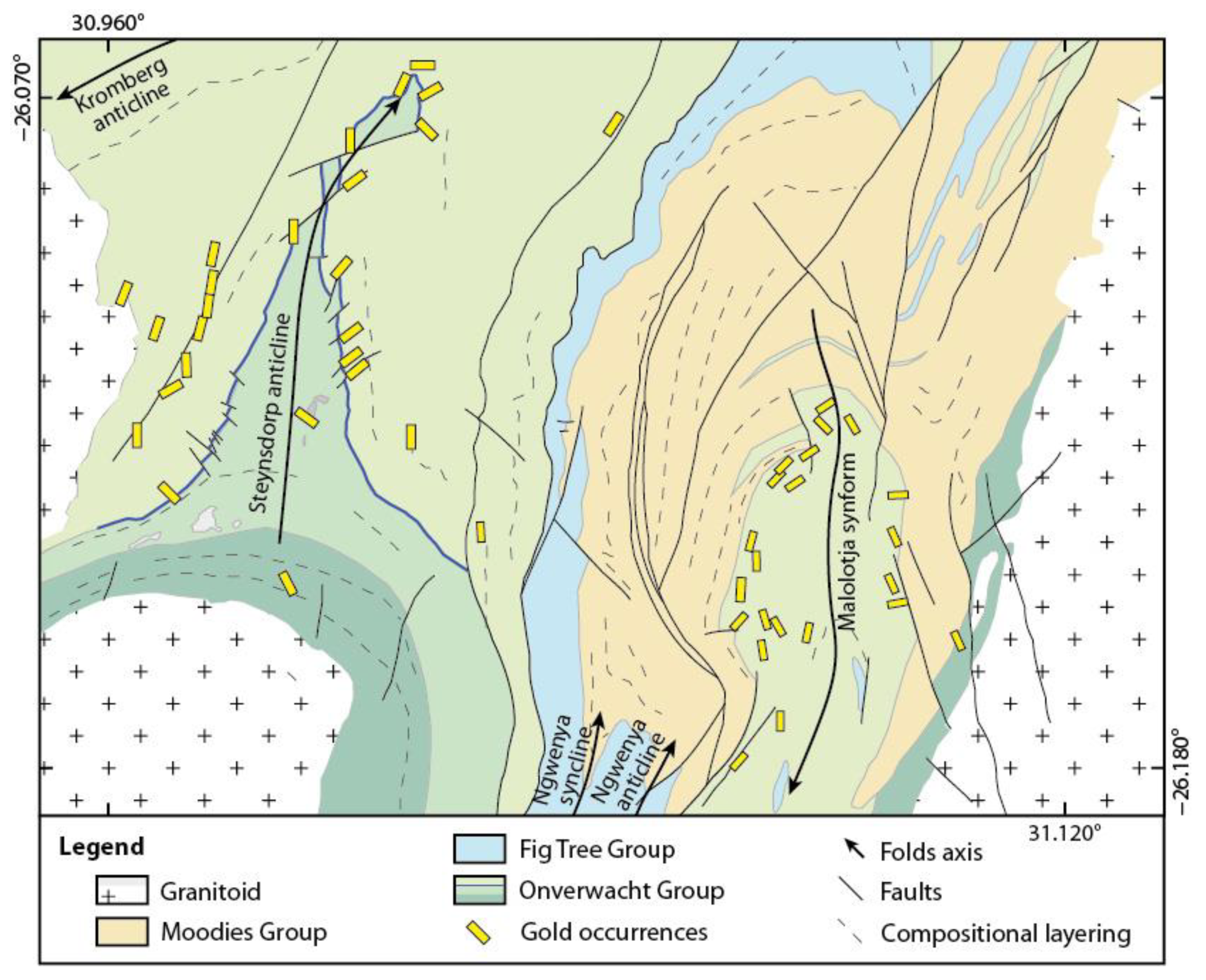
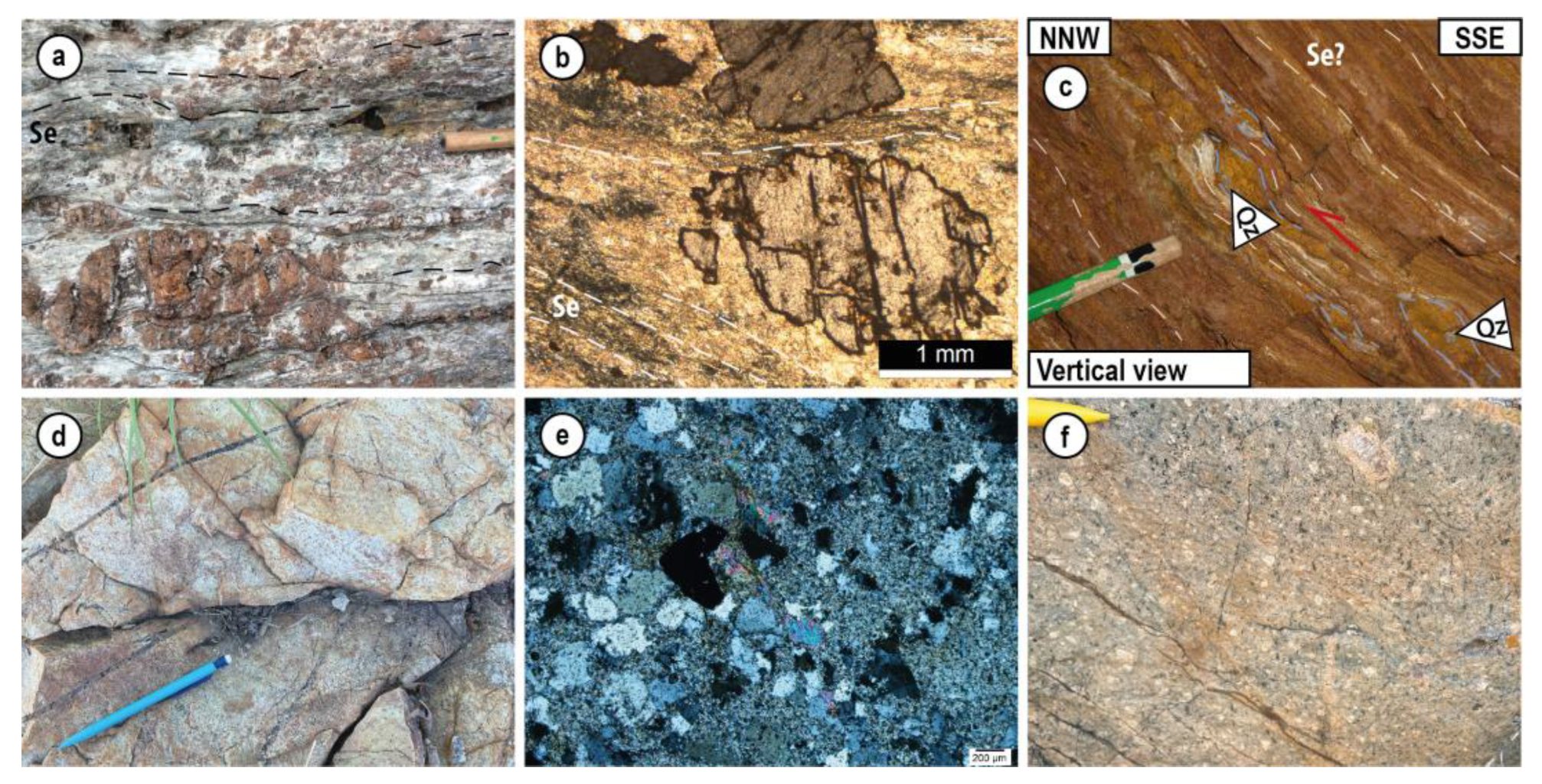

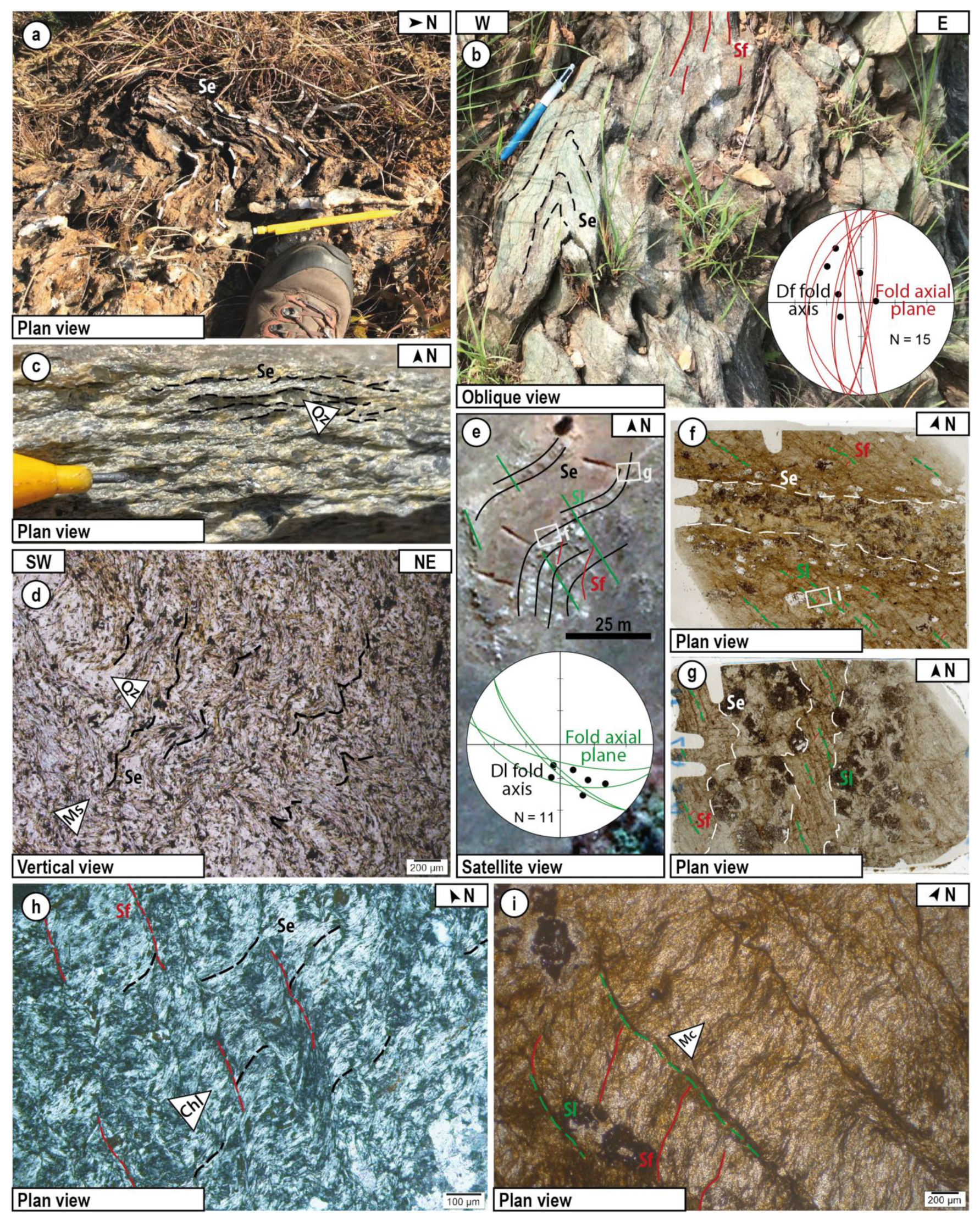

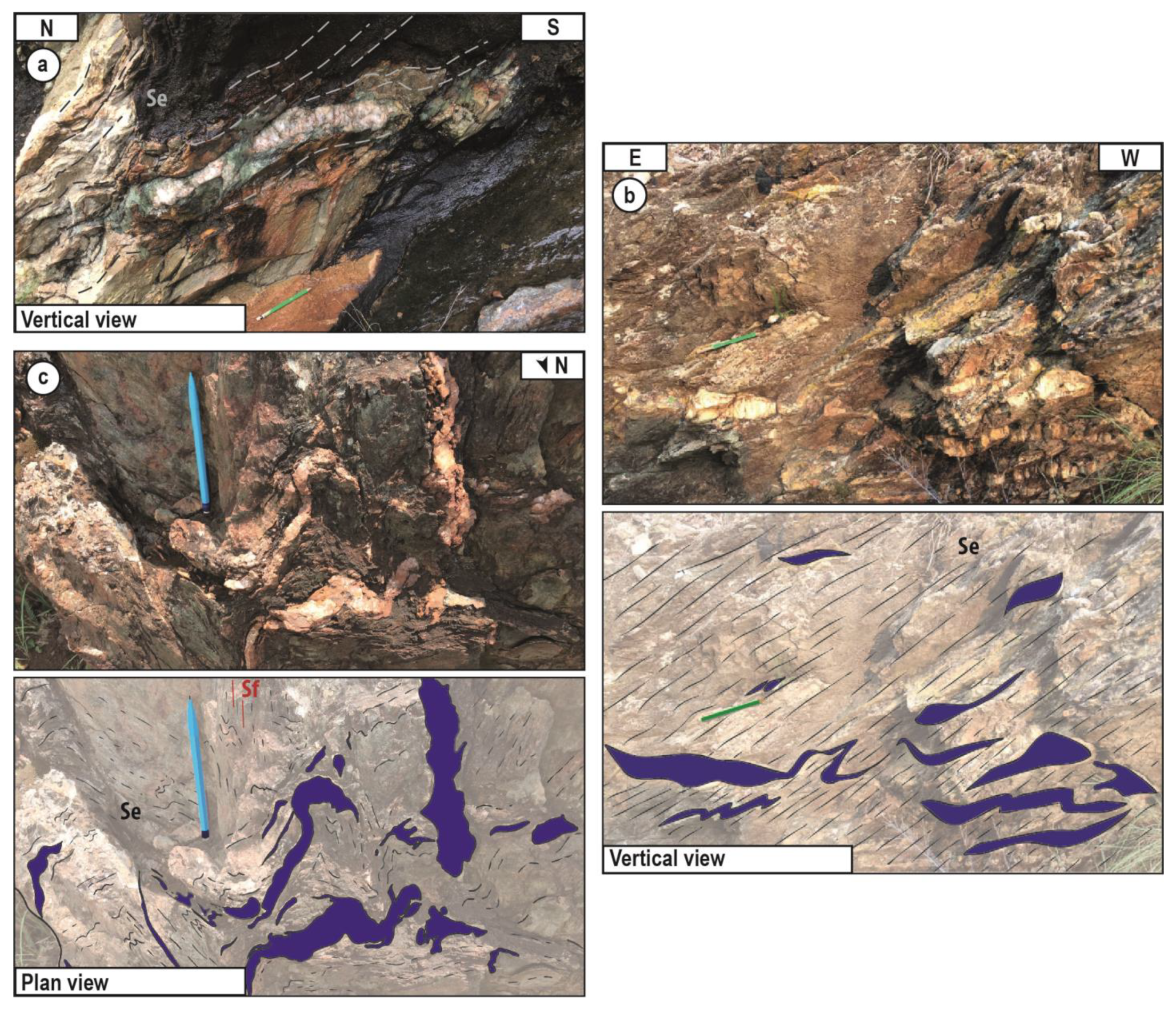
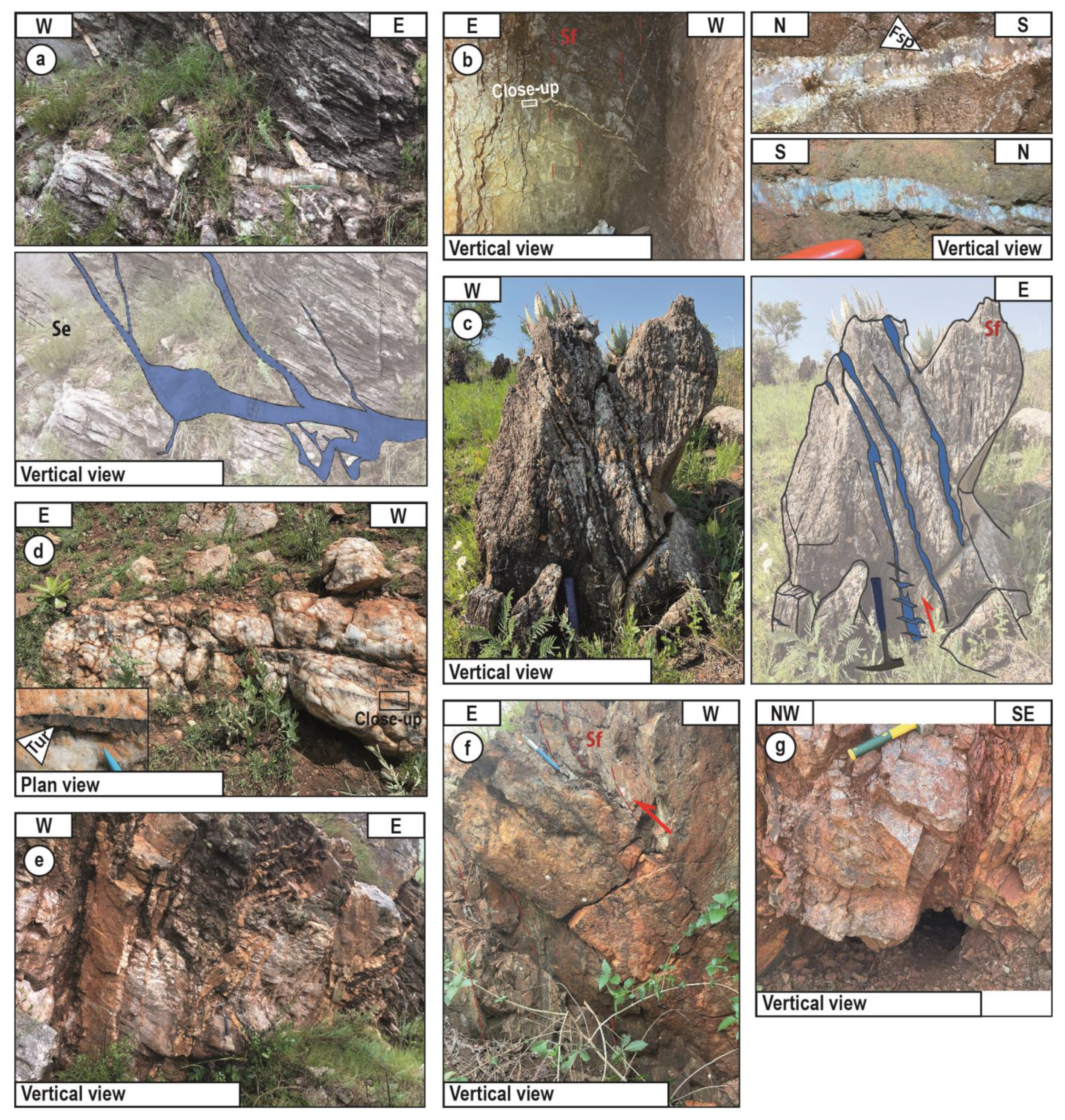
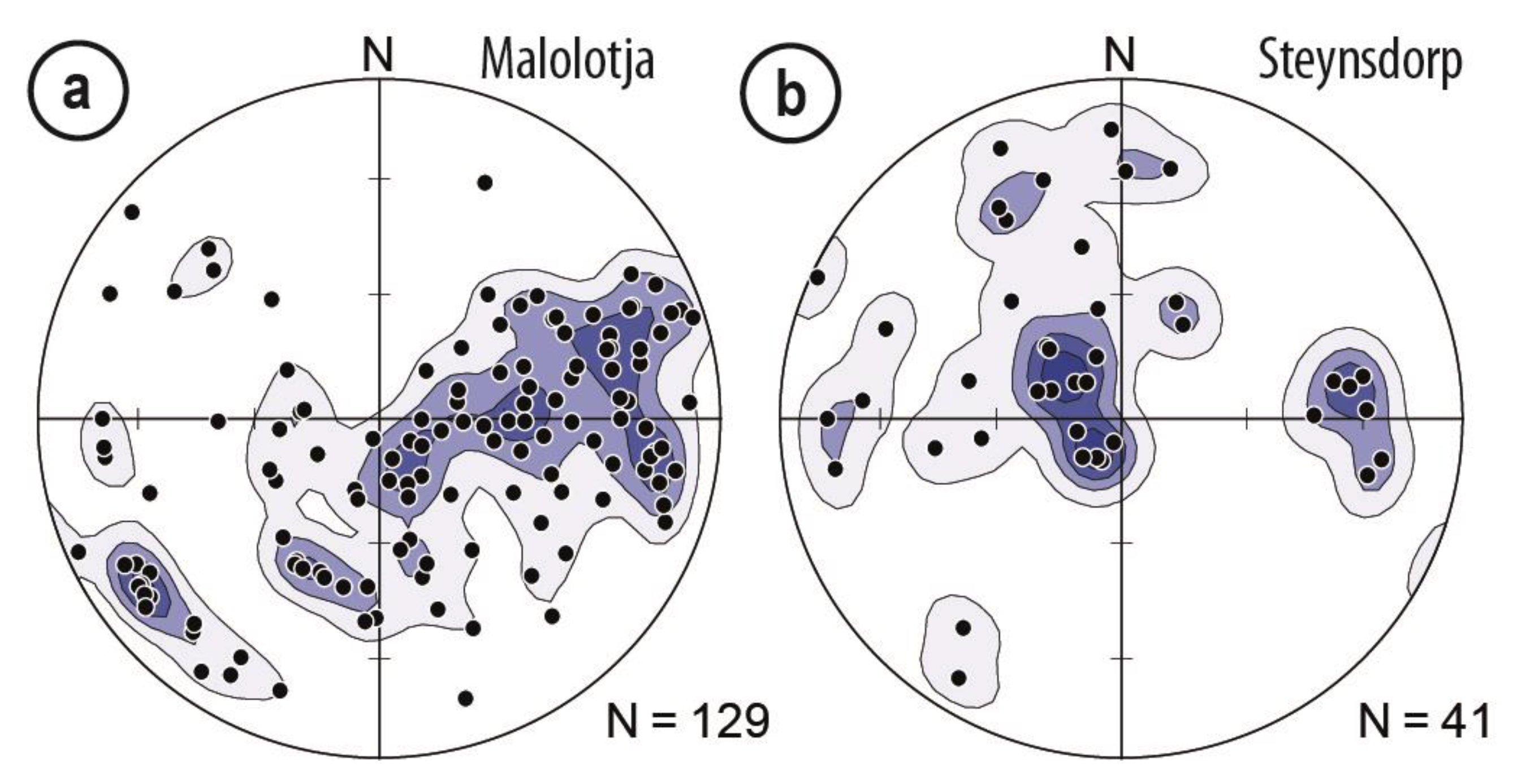



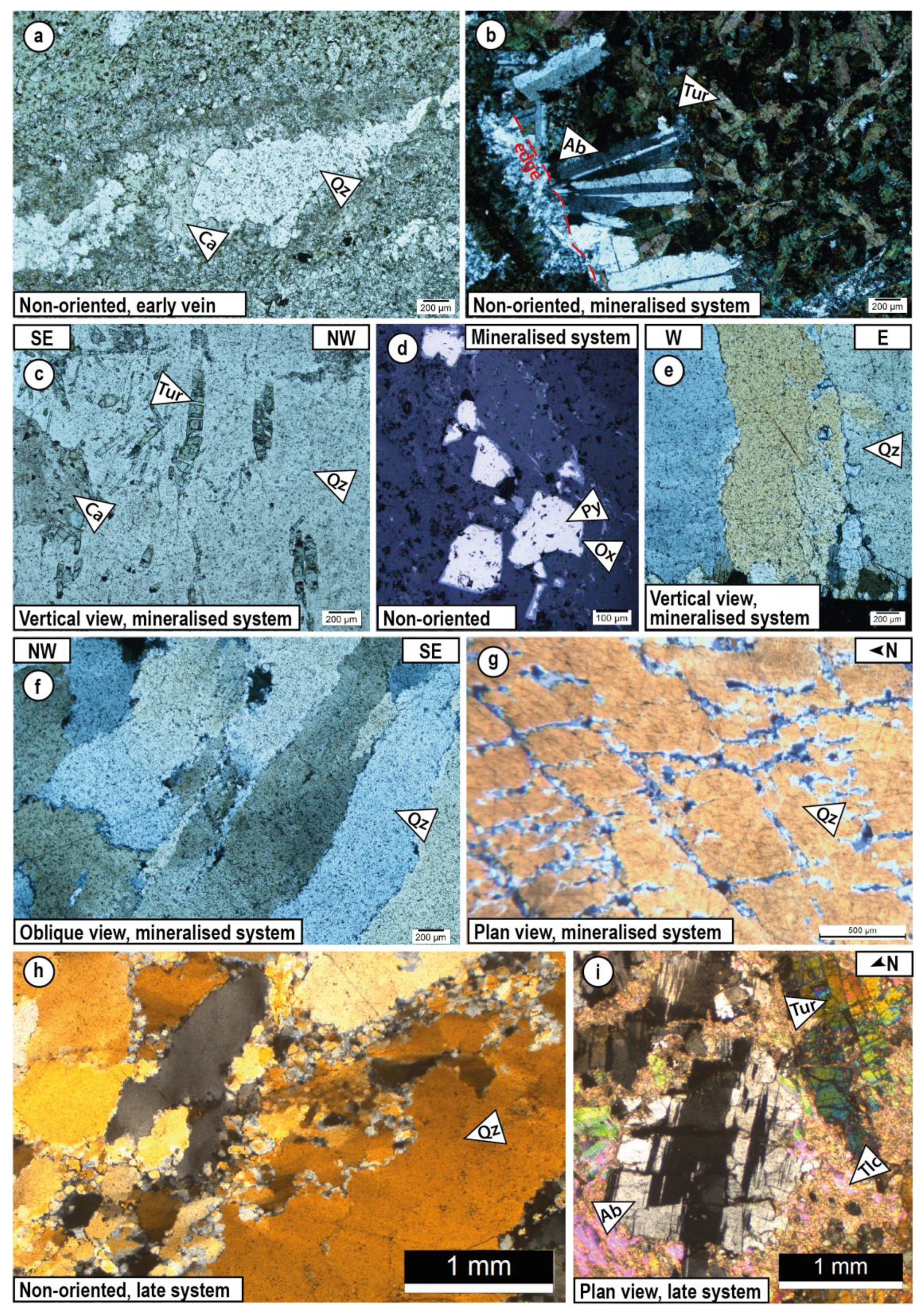

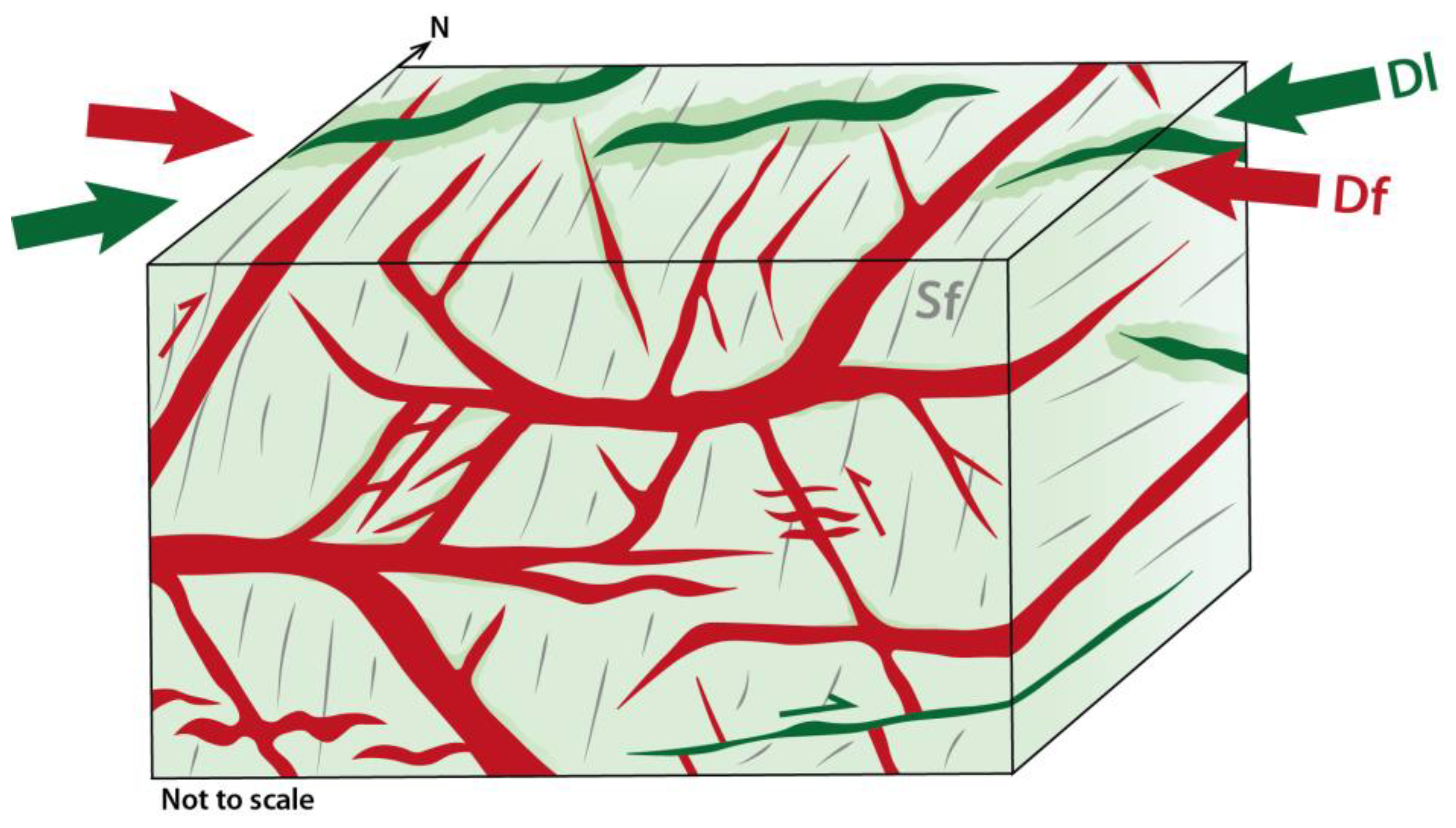
Disclaimer/Publisher’s Note: The statements, opinions and data contained in all publications are solely those of the individual author(s) and contributor(s) and not of MDPI and/or the editor(s). MDPI and/or the editor(s) disclaim responsibility for any injury to people or property resulting from any ideas, methods, instructions or products referred to in the content. |
© 2023 by the authors. Licensee MDPI, Basel, Switzerland. This article is an open access article distributed under the terms and conditions of the Creative Commons Attribution (CC BY) license (https://creativecommons.org/licenses/by/4.0/).
Share and Cite
Travers, L.; Chauvet, A.; Lehmann, J. Structure and Distribution of the Gold-Related Quartz Vein Systems in the Southwestern Part of the Barberton Greenstone Belt (South Africa, Eswatini). Minerals 2023, 13, 1034. https://doi.org/10.3390/min13081034
Travers L, Chauvet A, Lehmann J. Structure and Distribution of the Gold-Related Quartz Vein Systems in the Southwestern Part of the Barberton Greenstone Belt (South Africa, Eswatini). Minerals. 2023; 13(8):1034. https://doi.org/10.3390/min13081034
Chicago/Turabian StyleTravers, Laurine, Alain Chauvet, and Jérémie Lehmann. 2023. "Structure and Distribution of the Gold-Related Quartz Vein Systems in the Southwestern Part of the Barberton Greenstone Belt (South Africa, Eswatini)" Minerals 13, no. 8: 1034. https://doi.org/10.3390/min13081034
APA StyleTravers, L., Chauvet, A., & Lehmann, J. (2023). Structure and Distribution of the Gold-Related Quartz Vein Systems in the Southwestern Part of the Barberton Greenstone Belt (South Africa, Eswatini). Minerals, 13(8), 1034. https://doi.org/10.3390/min13081034






